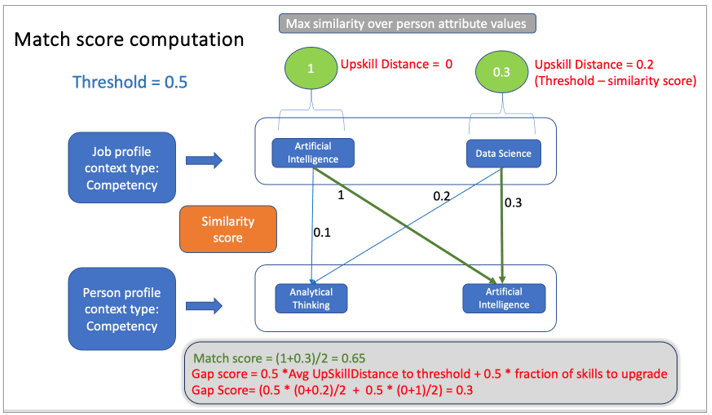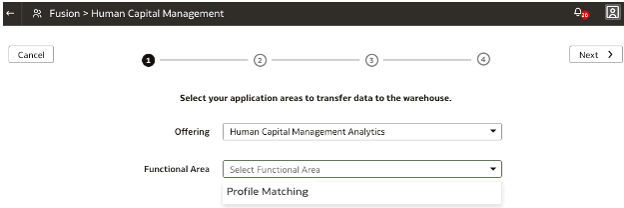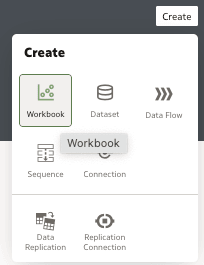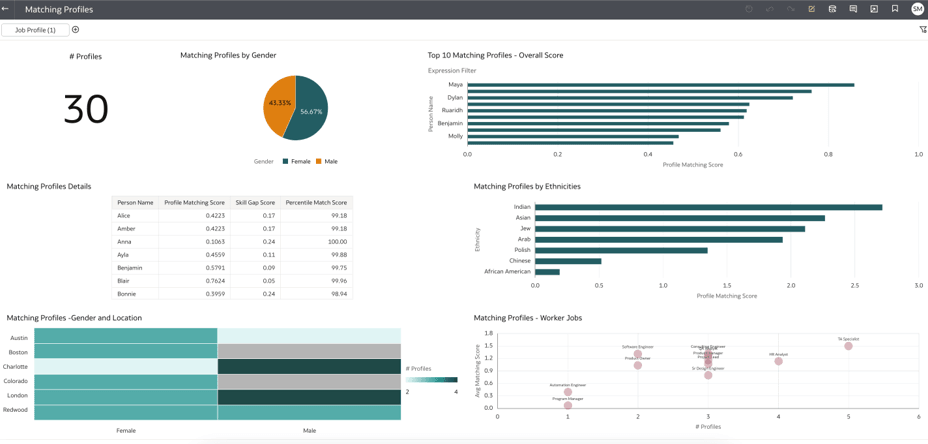Profile Matching
The Profile Matching subject area semantically compares a worker's talent profile attributes such as degrees, competencies, memberships, licenses, certificates, languages, honors, and awards with all available job profiles in Oracle Fusion HCM Analytics.
Profile Matching assigns a match score for each attribute, an overall score, a percentile match score, and a skill gap score. Additionally, this subject area suggests upskilling requirements for the worker to become eligible for specific job profiles. The application stores the information in the HCM – Profile Matching subject area.
Example
Assume the job profile requires competencies in Artificial Intelligence and
Data Science. The Profile Matching subject area runs a trained similarity algorithm
against the worker's talent profile, assigning a matching score for each competency. If
the worker's talent profile includes Artificial Intelligence, then it assigns a value of
1. If the job requires Data Science but the worker has only Analytical Thinking, the
application assigns a similarity value of 0.3 based on vector representation of cosine
similarity of embeddings. Profile Matching provides similarity scores for all
attributes, and the matching score is the average of these items; in this case, it would
be (1 + 0.3) / 2 = 0.65. The application also provides an upskilling requirement for
each of the attributes that can help a worker become eligible for the job profile.
Attributes with a score less than 0.5 are shown as upskilling requirements for the
candidate. 
Description of the illustration fahia-match-score-computation.png
- -1 indicates exactly opposite characteristics to those required by the job.
- 1 indicates exactly similar characteristics to those required by the job.
- 0 indicates that the characteristics of person profile are neither opposite nor similar to those required by job; they are unrelated.
If there are 5 job profiles and there are 10 workers with active talent
profiles, then the profile attributes of all these active workers are compared with the
5 of those job profiles. 
Prerequisites
- The Workforce Management functional area, Talent Profile functional area, and HCM - Talent Profile subject area.
- All Fusion HCM profiles must be configured with the following
attributes:
- Degrees
- Competencies
- Memberships
- License and certificates
- Languages
- Honors and Awards
Tips to Configure for Profile Matching
To use Profile Matching properly, you need to configure the following:
- Enable Profile Matching under Functional Areas from the Generally Available Features tab on the Enable Features page. See Enable Generally Available Features.
- Create a data pipeline for the Profile Matching functional area. While
creating the data pipeline, be sure to perform the following steps:
- Select Human Capital Management under Applications on the Console.
- In step 1 of the wizard to create a data pipeline, select
Human Capital Management Analytics in
Offering and Profile
Matching in Functional Area.

- In step 2 of the wizard to create a data pipeline, in
Number of desired matches, select an appropriate
value such as 100. Based on the chosen value, the application renders the
top number of matching profiles. For example, if you specify 100, then you
will see the top 100 matching profiles. If you want to match all profiles,
choose -1 for the number of desired matches.

Analyze Employee Profile Matching
Once the data load is complete, you can create a workbook and analysis based on the HCM – Profile Matching subject area.
- Navigate to the Home page.

- Click Create, and click
Workbook..

- In Add Data, search for "Profile Matching" and select HCM –
Profile Matching in the results.

- View the subject area details. The Profile Matching subject area
contains the worker’s basic information, profile information like job profile, model
profile, person profile, profile score details, and gap details in the folders
within it. You can make use of the
attributes and facts to create your visualization.

- Understand and report on the following business questions:
- Provide me the list of workers, their skills, and their qualifications that match a model job profile.
- Of the workers that have a lesser profile matching score, provide me the details of skills and qualifications gaps.
- Which are the top 5 jobs that a worker can transition into based on their profile scores?
- Can I analyze the matching profiles by their availability across various locations, their age and tenure bands, gender, and ethnicities?

Frequently Asked Questions
Review these questions to improve your understanding of the Profile Matching application.
-
How much data is needed for the Profile Matching model to be accurate?
HCM - Profile Matching can work with a limited set of data because it semantically matches an active worker’s talent profile to job profiles.
-
What algorithms does the Profile Matching prediction model use?
HCM – Profile Matching uses embedding-based matching on measures of similarity between vectors.
-
How frequently does the model create Profile Matching predictions on future data?
There are no predictions in HCM - Profile Matching as it analyzes existing data.
-
How frequently is the Profile Matching model calibrated or trained?
Most models are calibrated and trained weekly.
-
Are there any external benchmarks considered in the Profile Matching model?
No.